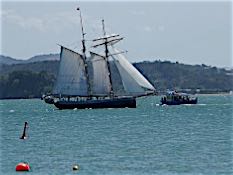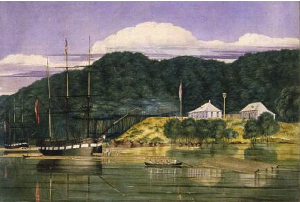 After Cook discovered New Zealand in 1769, Northland harbours became major refuelling and recreational ports for the early explorers of the Pacific exploration, the whalers and sealers.
After Cook discovered New Zealand in 1769, Northland harbours became major refuelling and recreational ports for the early explorers of the Pacific exploration, the whalers and sealers.
However, the numerous safe and sheltered anchorages of the Bay of Islands were much more attractive than Hokianga, whose entrance is guarded by its dangerous sand bar.
Whalers probably explored the harbour as early as the eighteenth century; but, until the missionaries Kendall and King crossed over from the Bay of Islands in July 1819, Hokianga was virtually unknown territory.
Samuel Marsden made a triumphant tour of all the major native settlements along the harbour.
The South Hokianga and Mangamuka river were well populated, but he found settlements in north Hokianga were sparse and relatively unimportant.
At this time, Maori could be regarded as semi-nomadic agriculturalists. Villages were often quite temporar ; huts and fortifications could be thrown up at a moments notice.
Communities were decentralised with family groups scattered all around the countryside.
It is likely that a rangatira of the Ihutae hapu, Wharepapa Tohu, was living at this time with his whanau at Kohukohu, or more precisely, at Tauteihihi, a sheltered inlet about a mile south of the present town.
Marsden's primary intention was to sound the bar and determine whether it was safe for large vessels to cross. although his report could not have been very encouraging, the Admiralty ship "Dromedary", seeking kauri spars for the royal Navy, tried to enter in 1820. It failed, but the little schooner accompanying it, the "prince Regent", commanded by Captain Kent, succeeded in becoming the first recorded ship to enter the Hokianga.
The Early Traders
 F. E. Maning, a Dubliner who emigrated to Sydney at the age of 13, purchased Kohukohu in 1834 and wrote an account of it in his semi-autobiographical classic "Old New Zealand".
F. E. Maning, a Dubliner who emigrated to Sydney at the age of 13, purchased Kohukohu in 1834 and wrote an account of it in his semi-autobiographical classic "Old New Zealand".
He married the sister of the Whirinaki chief Hauraki, and aspired to the mana and behaviour of a Maori rangatira.
Though never quite respectable, he was appointed a J.P. and Maori Land Court Judge in 1865, and his influence grew accordingly. Maning was not the first white man in Kohukohu. In 1830, Raine and Ramsey had to sell the Horeke shipyard, since a drought in Australia had led to the collapse of their enterprises there. The shipyard superintendent, Captain David Clark decided to move to Kohukohu, where he bought land from Wharepapa (although not the leader of his hapu, Wharepapa's mana as an invincible warrior gave him great authority)..

